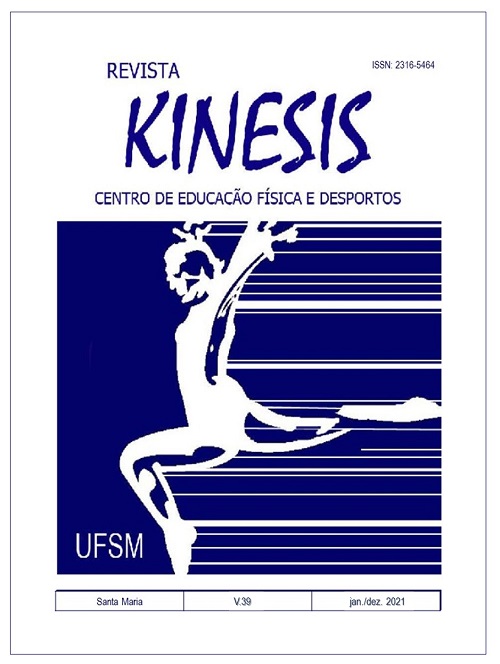Profile of junior handball athletes from brazilian and swedish teams
DOI:
https://doi.org/10.5902/2316546425918Keywords:
Handball, Sports career, PerformanceAbstract
This article compared the profile of handball junior athletes from Brazil and Sweden, aiming to understand the different contexts of its practice. For this, we applied a questionnaire with closed questions for the Junior category athletes of the Brazilian and Swedish team, during 2003 Men’s Junior World Handball Championship. Our results pointed out a difference between the sports career development of athletes of these two selections, in particular, the age of initiation and the beginning of federative competition, and there was difference also in salary gains. These elements indicate a better talent development of handball in Sweden than in Brazil, in the analyzed period.
Downloads
References
ARENA, S. S.; BÖHME, M. T. S. Federações esportivas e organização de competições para jovens. Revista Brasileira de Ciência e Movimento, v. 12, n. 4, p. 45–50, 2004.
BAYER, C. O ensino dos jogos desportivos colectivos.Paris: Vigot, 1994.
CARLI, G. C.; LUGUETTI, C. N.; RÉ, A. H. N.; BÖHME, M. T. S. Efeito da idade relativa no futebol. , 2009.
CÔTÉ, J.; LIDOR, R.; HACKFORT, D. ISSP position stand: To sample or to specialize? Seven postulates about youth sport activities that lead to continued participation and elite performance. International Journal of Sport and Exercise Psychology, v. 7, n. 1, p. 7–17, 2009.
DIESPORTE. Diagnostico Nacional do Esporte. Ministério do Esporte, 2013.
EHRET, A.; et al. Manual de handebol (Org. pela Confederação Alemã de Handebol-CAHb) São Paulo, Phorte, 2002.
GRECO, P. J.; BENDA, R. N. Iniciação esportiva universal: da aprendizagem motora ao treinamento técnico. Belo horizonte: UFMG, v. 1, p. 230, 1998.
GRECO, P. J.; ROMERO, J. J. F. Manual de handebol: da iniciação ao alto nível. São Paulo: Phorte, 2012.
HALLAL, P. C.; NASCIMENTO, R. R.; HACKBART, L.; ROMBALDI, A. J. Fatores intervenientes associados ao abandono do futsal em adolescentes. Revista Brasileira de Ciência e Movimento, v. 3, p. 27–32, 2004.
MARQUES, M. P.; SAMULSKI, D. M. Análise da carreira esportiva de jovens atletas de futebol na transição da fase amadora para a fase profissional: escolaridade, iniciação, contexto sócio-familiar e planejamento da carreira. Revista Brasileira de Educação Física e Esporte, v. 23, n. 2, p. 103–119, 2009.
MARTINS, L. N. Futsal Feminino: perfil das atletas nos Jogos de Minas 2012 e implicações pedagógicas. RBFF-Revista Brasileira de Futsal e Futebol, v. 5, n. 18, 2013.
MENEZES, R. P.; DOS REIS, H. H. B.; TOURINHO FILHO, H. Ensino-aprendizagem-treinamento dos elementos técnico-táticos defensivos individuais do handebol nas categorias infantil, cadete e juvenil. Movimento, v. 21, n. 1, p. 261–273, 2015.
REIS, H. H. B.; CASTELLANI, R. M. O perfil das disciplinas de handebol das instituições de ensino superior. Kinesis, v. 31, n. 1, 2013.
REIS, H. H. B.; CASTELLANI, R. M. Caracterização dos cursos de handebol nas instituições de ensino superior públicas. Conexões, v. 10, n. 2, 2012.
DE ROSE JUNIOR, D. A competição como fonte de estresse no esporte. Rev. Bras. Ciên. e Mov. Brasília v, v. 10, n. 4, p. 19–26, 2002.
SANTANA, W. C. REIS, H.H.B Futsal feminino: perfil e implicações pedagógicas. Rev. bras. ciênc. mov, v. 11, n. 4, p. 45–50, 2003.
SANTANA, W. C.; FRANÇA, V. S.; REIS, H. H. B. Perfil do processo de iniciação ao futsal de jogadores juvenis Paranaenses. Motriz rev. educ. fís.(Impr.), v. 13, n. 3, p. 181–187, 2007.
STAMBULOVA, N.; ALFERMANN, D.; STATLER, T.; CÔTÉ, J. ISSP position stand: Career development and transitions of athletes. International journal of sport and exercise psychology, v. 7, n. 4, p. 395–412, 2009.
Downloads
Published
How to Cite
Issue
Section
License
The works must be submitted in the digital format of the SEER platform, via the electronic address: http://periodicos.ufsm.br/kinesis/index. In case of any doubts, contact the editorial team through the email kinesisrevista@ufsm.br. The authorship that publishes in the Kinesis journal agrees to the following terms:
- They retain copyright and grant the journal the right of first publication.
- They allow and are encouraged to publish and disseminate their work online (e.g., in institutional repositories or on their personal page) as this can cause positive alterations, as well as increase the impact and quotation of the published work.







